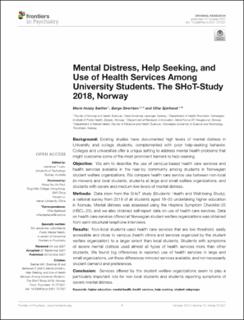| dc.contributor.author | Sæther, Marie Husøy | |
| dc.contributor.author | Sivertsen, Børge | |
| dc.contributor.author | Bjerkeset, Ottar | |
| dc.date.accessioned | 2022-03-01T10:10:34Z | |
| dc.date.available | 2022-03-01T10:10:34Z | |
| dc.date.created | 2021-11-22T10:40:25Z | |
| dc.date.issued | 2021 | |
| dc.identifier.citation | Frontiers in Psychiatry. 2021, 12 . | en_US |
| dc.identifier.issn | 1664-0640 | |
| dc.identifier.uri | https://hdl.handle.net/11250/2982011 | |
| dc.description.abstract | Background: Existing studies have documented high levels of mental distress in University and college students, complemented with poor help-seeking behavior. Colleges and universities offer a unique setting to address mental health problems that might overcome some of the most prominent barriers to help-seeking.
Objective: We aim to describe the use of campus-based health care services and health services available in the near-by community among students in Norwegian student welfare organizations. We compare health care service use between non-local (in-movers) and local students, students at large and small welfare organizations, and students with severe and medium-low levels of mental distress.
Methods: Data stem from the SHoT study (Students' Health and Well-being Study), a national survey from 2018 of all students aged 18–35 undertaking higher education in Norway. Mental distress was assessed using the Hopkins Symptom Checklist-25 (HSCL-25), and we also obtained self-report data on use of health care services. Data on health care services offered at Norwegian student welfare organizations was obtained from semi-structural telephone interviews.
Results: Non-local students used health care services that are low threshold, easily accessible and close to campus (health clinics and services organized by the student welfare organization) to a larger extent than local students. Students with symptoms of severe mental distress used almost all types of health services more than other students. We found big differences in reported use of health services in large and small organizations, yet these differences mirrored services available, and not necessarily student demand and preferences.
Conclusion: Services offered by the student welfare organizations seem to play a particularly important role for non-local students and students reporting symptoms of severe mental distress. | en_US |
| dc.language.iso | eng | en_US |
| dc.publisher | Frontiers | en_US |
| dc.rights | Navngivelse 4.0 Internasjonal | * |
| dc.rights.uri | http://creativecommons.org/licenses/by/4.0/deed.no | * |
| dc.title | Mental Distress, Help Seeking, and Use of Health Services Among University Students. The SHoT-Study 2018, Norway | en_US |
| dc.type | Peer reviewed | en_US |
| dc.type | Journal article | en_US |
| dc.description.version | publishedVersion | en_US |
| dc.source.pagenumber | 0 | en_US |
| dc.source.volume | 12 | en_US |
| dc.source.journal | Frontiers in Psychiatry | en_US |
| dc.identifier.doi | 10.3389/fpsyt.2021.727237 | |
| dc.identifier.cristin | 1957157 | |
| cristin.ispublished | true | |
| cristin.fulltext | original | |
| cristin.qualitycode | 1 | |

